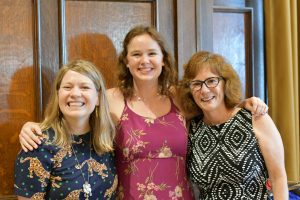After Professors Trish Devine and Kristin Shutts discussed their research interests related to social biases and prejudice, they hoped to share their expertise in social psychology and developmental psychology with students, as well as each other.
From these discussions, the idea to co-teach a course on the origins, development and reduction of social biases throughout life emerged.
“We found our discussions to be exciting and provocative and wanted to share what we had been exploring with students,” Devine says. “Teaching the class on the origins and reductions of prejudice provided a perfect opportunity to achieve these goals.”

Shutts is a developmental psychologist interested in the origins of social biases, social categorization, and intergroup bias in children. Devine is a social psychologist interested in the reduction of social biases, social categorization, and intergroup bias in adults.
“Teaching together provided a perfect opportunity to explore connections and learn more about each other’s perspectives, as well as perspectives from different fields,” Shutts says.
Devine and Shutts have recently collaborated on research studying bias in both children and adults.
“Our interests allow us to take somewhat of a life span approach to thinking about what leads to the development of prejudice and stereotypes and reducing prejudice,” Devine says. “We have different areas of expertise that leads us to bring different theories and research findings to bear on the problem of bias.”
Devine and Shutts co-taught the graduate level Prejudice Development and Reduction course in the fall of 2012 and 2016 and again this past spring.
“This year when we sat down to work on the syllabus, it was a bit easier and more seamless because we know each other really well now and we have developed more overlapping, integrated expertise and knowledge over the past several years,” Shutts says.
The course begins by addressing questions including what prejudice is and how bias can be assessed. The course then focuses on theories of bias emergence, the forces that contribute to bias, and how and why people develop different levels and types of bias. The second half of the course focuses on common approaches to bias reduction and students develop a final project proposing their own bias intervention.
Before weekly class meetings, Shutts and Devine discuss the assigned readings and student responses and create a general discussion plan for class.
Once in class, Shutts and Devine let the teaching unfold naturally. They build on each other’s points and alternate leading discussions.
Students not only learn from instructors bringing different knowledge and perspectives to the course, but they also witness the collaboration that occurs in science.
“[Students] get to see a model of collaborative science unfold in our class – i.e., how people from different research traditions can profitably work and think together, and what the benefits of doing so are,” Shutts says.
Graduate students in the course from multiple departments and schools across campus also bring their own perspectives. In addition to students from the Department of Psychology, the course this semester also has students from the Human Development and Family Studies program in the School for Human Ecology, the Department of Communication Arts, the School of Journalism and Mass Communication and the School of Education.
“It has been really interesting to hear those students’ perspectives, and for our psychology Ph.D. students to learn from those students, too (and vice versa),” Shutts says.
Shutts says she has learned much from students and literature and theory from social psychology through the course.
“I’ve also learned to think of more familiar theories and data [from developmental science] in different ways by hearing how people from different backgrounds react to those ideas,” Shutts says.
Devine says she has also learned much from discussing the origins of social biases and literature in developmental psychology, with each semester bringing new insights.
“We push each other on issues and have a great deal of fun developing our class sessions to draw the best out of our students and each other,” Devine says. “The give and take during the planning sessions and our class sessions is exciting, particularly when we generate something novel neither we nor the students had previously considered.”
Written by Sara Stanislawski x’25